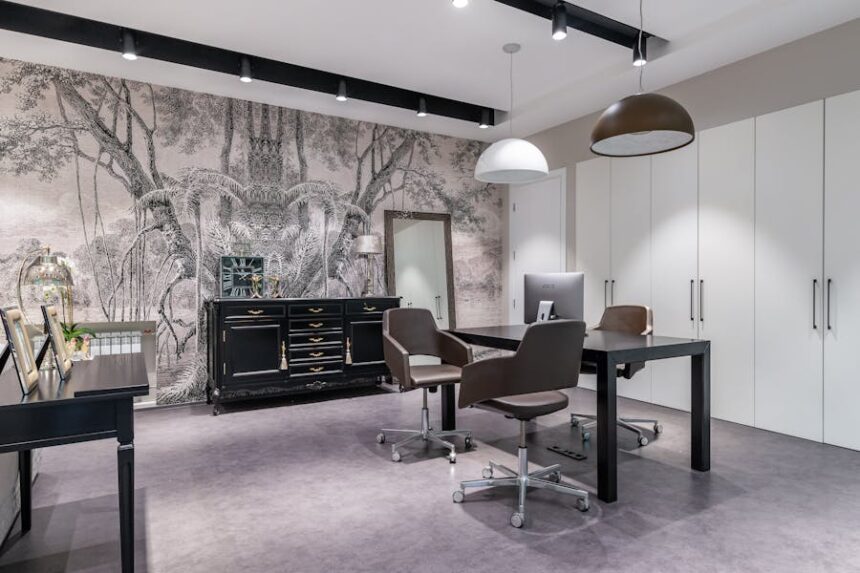Community spaces hold a special place in our lives. From libraries and town halls to daycare centers and co-working hubs, these areas are meant to inspire connection, comfort, and creativity. But too often, the design of these shared environments is overlooked. Walls are left blank or coated in neutral paints that fail to reflect the energy of the people using them.
That’s where wallpaper comes in—not just any wallpaper, but custom wallpapers tailored to the space’s purpose and the community it serves. Through thoughtful design and texture, wallpaper has the ability to define atmosphere, express identity, and bring a dynamic visual element to even the simplest rooms.
Why Custom Wallpaper Makes a Difference
Unlike generic wall art or one-size-fits-all design solutions, custom wallpapers provide an opportunity to tell a story. Whether you’re decorating a wellness center focused on healing or a youth center brimming with energy, custom wallpapers allow you to infuse meaning into every wall.
Custom designs can include patterns, quotes, illustrations, photography, and logos—all aligned with the purpose of the space. These aren’t just decorative elements; they become part of the space’s identity and contribute to the experience of every visitor.
Top Benefits of Custom Wallpaper:
- Visual storytelling: Reflect your space’s values, culture, or purpose with intentional artwork.
- Tailored aesthetics: Choose styles, fonts, and color palettes that fit the space perfectly.
- High impact: A single wallpapered wall can completely change how a space feels.
- Long-lasting appeal: Unlike temporary posters or seasonal decorations, custom wallpaper remains relevant and attractive for years.
Where to Use Custom Wallpaper in Community Spaces
Wallpaper isn’t just for homes or boutique hotels. Community spaces of all kinds can benefit from the energy and warmth of custom-designed walls.
Public Libraries
Imagine walking into a children’s reading area adorned with colorful murals of forest animals, storybook characters, or inspirational quotes. Custom wallpaper can transform dull walls into scenes of wonder that inspire young minds.
For adult areas, consider literary quotes, textured maps, or historic references to tie the space into the local culture.
Healthcare Clinics and Wellness Centers
Soothing wallpaper designs can reduce stress for both patients and staff. Nature-inspired prints, soft pastel patterns, or abstract shapes add a healing touch. Wallpaper is also easier to clean and maintain in medical spaces compared to painted walls.
Community Centers
Whether hosting local meetings, fitness classes, or art workshops, community centers benefit from flexible designs. Custom wallpapers can highlight local landmarks, traditions, or community missions, giving everyone a sense of pride and connection.
Schools and Daycares
Kids thrive in colorful, engaging environments. Wallpaper can be interactive and educational—think numbers, alphabets, animals, or maps. In high-traffic zones, use durable wallpaper that’s washable and scuff-resistant to keep it looking fresh and fun.
Co-Working Spaces
Productivity and creativity go hand in hand. Custom wallpaper in break rooms or brainstorming zones can energize employees. Motivational phrases, clean geometric patterns, or biophilic designs help build an atmosphere where ideas thrive.
Why White Textured Wallpaper Works Wonders
While bold patterns and colorful scenes have their place, not every space calls for visual stimulation. Sometimes, subtlety says more.
That’s where white textured wallpaper shines. Its understated elegance creates visual depth without overpowering the room. It adds dimension, reflects light, and works seamlessly in both modern and traditional environments.
Ideal Spaces for White Textured Wallpaper:
- Reception areas to make a great first impression
- Conference rooms where calm, focused energy is needed
- Corridors and hallways that often lack personality
- Art galleries where the wall needs to support rather than compete with the artwork
Whether you opt for linen-like finishes, geometric embossing, or organic waves, white textured wallpaper creates a foundation of sophistication and cleanliness.
Combining Custom Wallpaper with White Texture
You don’t have to choose between color and texture—you can have both. Many designers pair custom feature walls with surrounding white textured wallpaper for a balanced aesthetic.
For instance:
- A children’s corner may have a colorful forest mural on one wall and white textured panels to keep the rest of the room grounded.
- A wellness center might use a calming quote in custom type across a back wall, balanced with textured neutrals throughout the space.
This blend offers flexibility. It lets you inject personality without overwhelming the environment, especially in multipurpose or transitional rooms.
Practical Tips for Wallpapering Community Spaces
-
Know Your Audience
Design with your users in mind. Kids love bright and bold. Professionals prefer clean and modern. Seniors may enjoy larger patterns and softer hues. Match the vibe with the space’s purpose.
-
Choose the Right Material
High-traffic areas demand durable materials. Opt for vinyl-coated or peel-and-stick wallpapers that are easy to clean and maintain.
-
Sample Before You Commit
Order samples from reputable sources like Love vs Design to see how patterns look in real lighting. This helps avoid surprises post-installation.
-
Think About Installation
Some wallpapers require professional installation, especially textured and patterned ones. Consider budget and timeline accordingly.
-
Don’t Overdo It
Not every wall needs wallpaper. Use it strategically to create focal points and visual flow.
Conclusion: A Wall That Speaks Volumes
In shared spaces, walls do more than divide rooms—they communicate values, set tone, and build community. By choosing custom wallpapers, you bring depth, warmth, and intention into your design.
Whether you’re aiming for energy, elegance, or emotional connection, these wall treatments help create memorable environments that inspire and unite. After all, in places built for people, every detail matters—and every wall can tell a story.




